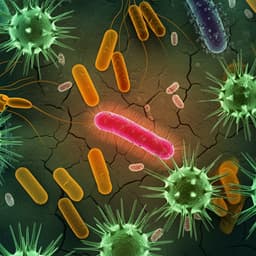
Medicine and Health
Advances in the application of molecular diagnostic techniques for the detection of infectious disease pathogens (Review)
Q. Liu, X. Jin, et al.
Discover how recent advancements in molecular diagnostic techniques are revolutionizing the diagnosis of infectious diseases. This captivating review by Qingqing Liu, Xiaojuan Jin, Jun Cheng, Huajun Zhou, Yingjie Zhang, and Yuzhu Dai explores innovative methods such as PCR and high-throughput sequencing, comparing their benefits and applications.
~3 min • Beginner • English
Introduction
Infectious diseases, caused by bacteria, viruses, parasites and fungi, remain leading causes of global morbidity and mortality. Approximately 60 million deaths occur annually worldwide, with at least 25% attributable to infectious diseases. Emerging pathogens and drug-resistant organisms challenge public health and socioeconomic stability. While vaccines and antimicrobials help, their efficacy can be undermined by novel agents and resistance, and development cycles are lengthy. In the absence of specific vaccines or drugs, rapid, accurate pathogen identification is essential to guide treatment and control spread. Traditional methods (culture, hemagglutination inhibition, ELISA) are time-consuming or limited by sensitivity/specificity and stability. With advances in genetics and genomics, nucleic acid-based molecular diagnostics provide faster, more sensitive and specific detection, enable multiplex pathogen detection, resistance gene analysis, and homology/epidemiologic studies. Common molecular techniques for infectious diseases include PCR (qPCR, digital PCR, HRM), isothermal amplification (LAMP, RPA, NASBA), gene chips (solid- and liquid-phase), and high-throughput sequencing (NGS, TGS).
Literature Review
This narrative review synthesizes recent advances across major molecular diagnostic platforms for infectious diseases. It details principles, workflows, and performance characteristics; highlights representative studies demonstrating clinical utility; and compares advantages, limitations, applicability, and costs. Evidence includes examples where qPCR outperforms culture, multiplex qPCR panels for respiratory pathogens, dPCR for absolute quantification and detection of low-abundance targets and rare variants, HRM for rapid genotyping and resistance mutation detection, isothermal methods (LAMP, RPA, NASBA) for resource-limited and point-of-care use with various endpoint readouts, gene chips for multiplex detection and resistance genotyping (e.g., MTB rifampicin/isoniazid resistance), and sequencing (NGS and TGS) for comprehensive detection, outbreak tracing, and mutation surveillance. Summaries reference sensitivity/specificity, limits of detection, turnaround times, and instrument/cost considerations, as compiled in Tables I and II and illustrated by figures for each technology.
Methodology
This is a narrative review. The authors summarize and compare molecular diagnostic techniques for infectious disease pathogen detection based on published literature, illustrating principles (via figures), example clinical applications, performance metrics (e.g., limits of detection, sensitivity/specificity), costs, instrumentation, and suitability for various settings. No systematic search strategy, inclusion/exclusion criteria, or meta-analytic methods are described. The review presents comparative tables (sample types, preparation, LoD, time, costs; applicability, advantages, limitations, and common sources of false results).
Key Findings
- qPCR: Real-time fluorescence-based amplification offers high sensitivity/specificity, automation, and shorter turnaround versus conventional PCR and culture. Examples show higher detection rates than culture for pneumococcus and Porphyromonas gingivalis. Multiplex qPCR (MqPCR) can detect multiple pathogens in one reaction (e.g., nine respiratory pathogens; adenovirus/astrovirus/rotavirus/sapovirus), with LoD commonly around 100–500 copies/ml and reduced time/cost per sample. Limitations include contamination risk, primer-dimer artifacts, inhibitors causing false-negatives, and reliance on expensive thermocyclers and trained personnel.
- Digital PCR (dPCR): Partitioned reactions enable absolute quantification without standard curves, improving detection of low-level pathogens and rare variants (<0.1%). Applied to HRV, HIV reservoirs, HPV cfDNA, and MTB in infant blood. Sensitivity to thresholding and droplet quality is noted; costs are high and workflows can be contamination-prone during droplet prep. Suitable for incubation/low-load monitoring.
- High-Resolution Melting (HRM): Post-PCR analysis distinguishes sequence variants by melting curve shapes. Demonstrated for rapid fungal identification, differentiation of Campylobacter spp., and detection of oseltamivir resistance (H275Y) in H1N1 with ~62 min run time. It is fast, low-cost, and high-throughput but requires precise temperature uniformity and careful primer design.
- Isothermal amplification: Performed at constant temperature without thermocyclers, enabling rapid, simple detection with visual readouts (turbidity/color/LFA/fluorescence).
• LAMP: Operates at 60–65°C using multiple primers; can amplify up to 10^9–10^10 copies in 15–60 min. Variants improve speed/specificity. Multiplex LAMP differentiated MTB vs. NTM with ~100% specificity and ~98–100% sensitivity; integrations with LFA and microfluidics enabled low-cost HIV-1 detection from whole blood. Typical LoD ~10^1–10^2 copies/μl. Limitations: complex primer design, higher false-positive risk.
• RPA: Amplifies at 37–42°C in 5–30 min from 1–10 copies, tolerates simple sample prep and minimal equipment; often paired with LFA for endpoints. Demonstrations include adenovirus typing, HBV viral load screening, and device innovations (wearable PDMS, colorimetric multiplex). LoD ~10^1–10^2 copies/μl. Constraints include lack of specialized primer design tools and potential non-specific amplification.
• NASBA: RNA-targeted amplification at ~41°C with three enzymes, achieving ~10^12-fold amplification in ~90 min and suited to RNA viruses. RT-NASBA for SARS-CoV-2 achieved LoD ~200 copies/ml with ~97.6% clinical sensitivity vs. FDA-authorized RT-qPCR; NASBA-LFA detected dengue RNA with LoD ~1.2×10^4 PFU/ml. Longer/shorter targets (<120 or >250 bp) reduce efficiency; low-temperature reactions are prone to primer-dimers/non-specific amplification.
- Gene chips:
• Solid-phase microarrays: Multiplex hybridization to immobilized probes, enabling simultaneous detection/resistance genotyping (e.g., MTB rifampicin/isoniazid resistance in ~6 h). Platforms like FilmArray automate extraction-to-detection of >100 targets with ~1 h TAT for respiratory panels. Limitations include cost of fluorescent labeling and potential false-negatives with highly variable pathogens.
• Liquid-phase (suspension) arrays: Probe-coupled fluorescent beads with flow cytometric readout (e.g., Luminex xMAP). Panels such as xTAG Respiratory and Gastrointestinal Pathogen Panels achieve high throughput with reported overall sensitivity ~96.3% and specificity ~99.8% for GI panel. Suitable for large-scale screening; cross-reactivity must be managed.
- High-throughput sequencing:
• NGS: Culture-independent, broad-spectrum detection and genotyping; useful when routine tests are negative and for outbreak tracing and evolution monitoring. Challenges include complex sample prep, need for amplification, short reads, high run times/costs, and bioinformatics hurdles, particularly in interpreting complex data.
• TGS (e.g., Oxford Nanopore): Long reads, portable devices, and direct RNA sequencing reduce prep time and enable rapid field analyses (e.g., SARS-CoV-2, Ebola, adenovirus). Demonstrations include direct RNA sequencing of influenza A with high agreement to Illumina. Main limitation is higher error rate, though improving with better pores and base-calling.
- Other molecular diagnostics: Biosensing (optical/electrochemical) for rapid, label-free nucleic acid detection; flow-FISH for multiplex nucleic acid detection at single-cell level; and mass spectrometry platforms (e.g., MALDI) for rapid microbial identification.
- Comparative performance and costs (from Tables I–II): Typical sample volumes 200–300 μl; qPCR LoD 100–500 copies/ml (~2 h; low cost < $15/sample), dPCR similar LoD (~2 h; high cost > $70/sample), HRM ~1 h (< $15/sample), LAMP/RPA 15–60 min/5–30 min with LoD ~10^1–10^2 copies/μl (< $15/sample), NASBA 1.5–2 h (medium cost), gene chips 35–360 min (medium cost), NGS 24–48 h (high cost), TGS 10 min–6 h (high cost). Common false-positive/negative sources are enumerated for each method.
Discussion
The review addresses the core question of how molecular diagnostics can improve rapid, accurate detection of infectious pathogens compared with traditional methods. It demonstrates that technique selection should be tailored to clinical context, resource availability, and diagnostic goals: qPCR/MqPCR for routine and targeted multi-pathogen detection; dPCR for absolute quantification and low-abundance targets; HRM for rapid genotyping and resistance mutation screening; isothermal amplification (LAMP, RPA, NASBA) for point-of-care and resource-limited settings; gene chips for high-throughput, multiplex detection of known targets and resistance markers; and NGS/TGS for comprehensive, unbiased detection, outbreak tracing, and mutation surveillance. The synthesis underscores trade-offs among sensitivity/specificity, throughput, LoD, time-to-result, cost, instrument complexity, and susceptibility to contamination or inhibitors. It also highlights implementation challenges—sample preparation, need for cold-chain for reagents, and instrument dependence—as barriers to widespread adoption in low-resource settings, guiding priorities for technology development (automation, portability, and room-temperature-stable reagents).
Conclusion
In conclusion, molecular diagnostic technology provides an improved choice for the diagnosis of infectious diseases compared to traditional diagnostic techniques, such as microbial culture, hemagglutination inhibition tests, and ELISA. The careful selection and combination of different molecular diagnostic technologies according to a user's needs can provide a timely and accurate diagnosis of infectious disease pathogens and facilitate precision treatment, to effectively control diseases. qPCR technology is mature, low-cost and suitable for the qualitative and quantitative analysis of common pathogens in standard laboratories. dPCR can be used for the absolute quantification of target genes in samples, and is particularly suitable for the analysis of samples containing low pathogen levels, and the detection of small mutations and rare allele targets. As a fast, high-throughput and cost-effective technique, HRM is often used for mutation detection and large-scale analysis of single nucleotide polymorphisms.
Isothermal PCR can be used for nucleic acid amplification at a constant temperature, which does not require a thermocycler, and is more suitable for the rapid detection of pathogens in resource-limited areas and primary medical units. Gene chip technology has the ability to detect and identify multiple pathogens simultaneously, which is particularly useful in clinical settings for the pathogenic composition determination of mixed infections. However, this technology can only screen for the genomes of known pathogens and cannot detect new, unknown pathogens, unlike gene sequencing technology, which can comprehensively detect the types and sequences of pathogens. The molecular diagnostic techniques outlined in the present review need further improvement. First, nucleic acid extraction and purification steps in molecular diagnostic techniques are cumbersome. Therefore, it is essential to streamline the existing nucleic acid extraction procedures or develop molecular techniques to avoid nucleic acid extraction. Second, most molecular diagnostic reagents require low-temperature transport and storage, which increases the cost of molecular diagnostics and hinders their application in remote or resource-limited areas, so ready-to-use, room temperature-stable reaction mixtures need to be studied to reduce costs and increase their applicability in these areas. Finally, molecular diagnostic techniques such as qPCR, dPCR and sequencing are instrument-dependent, meaning that rapid on-site detection of pathogens in resource-limited conditions can prove difficult. Continuous improvement of molecular diagnostic technology will help to create more high-throughput, automated and portable instruments with high sensitivity and specificity to aid in the rapid diagnosis and treatment of infectious diseases worldwide.
Limitations
- Review-level limitations: This is a narrative review without a described systematic search strategy, selection criteria, or quantitative synthesis; thus, it may be subject to selection bias and does not provide meta-analytic effect estimates.
- Technique-level limitations highlighted: (a) qPCR—susceptible to contamination, inhibitors, and requires precise instrumentation; (b) dPCR—high cost, threshold-setting sensitivity, contamination risk during droplet handling; (c) HRM—requires stringent temperature control and primer design; (d) Isothermal methods—complex primer design and higher false-positive risk (LAMP), lack of specialized primer software and non-specific amplification (RPA), NASBA efficiency constraints for target length and higher false-positive risk due to low-temperature reactions; (e) Gene chips—dependence on known sequences, cost of fluorescent reagents, potential false-negatives for highly variable pathogens; (f) NGS—complex workflows, long run times, high cost, short reads, bioinformatics demands, and interpretation challenges; (g) TGS—higher error rates despite rapid turnaround and long reads.
Related Publications
Explore these studies to deepen your understanding of the subject.







